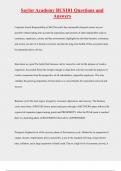Saylor Academy BUS101 Questions and
Answers
Corporate Social Responsibility (CSR) The belief that sustainable financial returns are not
possible without taking into account the aspirations and interests of other stakeholders such as
customers, employees, society and the environment; highlights the fact that business, consumers
and society are part of a shared ecosystem, and that the long-term health of this ecosystem must
be maintained above all else.
Innovation as a goal The belief that business can be viewed to exist for the purpose of creative
expansion. Successful firms like Google manage to align their activities towards the purpose of
creative expansion from the perspective of all stakeholders, especially employees. This also
validates the growing importance of innovation as a core principle for corporation survival and
success.
Business cycle Has four stages: prosperity, recession, depression, and recovery. The business
cycle starts from a TROUGH (lower point) and passes through a RECOVERY phase followed by
a period of expansion (upper turning point) and PROSPERITY. After the PEAK point is reached
there is a declining phase of RECESSION followed by a DEPRESSION.
Prosperity Highest level of the recovery phase of the business cycle. Marked by an expansion of
output, income, employment, prices and profits, a rise in the standard of living, rising interest
rates, inflation, and a large expansion of bank credit. Due to a high level of economic activity, it
, Saylor Academy BUS101 Questions and
Answers
causes a rise in prices and profits. There is an upswing in the economic activity and economy
reaches its PEAK.
Recession When a broad range of economic indicators falls for at least 6 months; the turning
point from prosperity to depression. Economic activities slow down and demand starts falling.
There is a steady decline in output, income, employment, prices and profits. Businessmen lose
confidence and become pessimistic. Investment is reduced and bank credit contracts. Business
expansion stops, stock market falls, orders are cancelled, and people start losing their jobs. The
increase in unemployment causes a sharp decline in income and demand. Generally, recession
lasts for a short period.
Depression Depression sets in when there is a continuous decrease of output, income,
employment, prices and profits causing a fall in the standard of living. Marked by a fall in
income, decline in consumption and demand, rise in unemployment, fall in interest rates,
contraction of bank credit and overall business pessimism. Economic activity is at the lowest,
and prices and profits decline until the economy reaches its TROUGH (low point)
Recovery The turning point from depression to prosperity. Marked by a rise in economic activity.
There is a steady rise in demand, output, production, employment, and income. Prices and profits
increase. Businesses become optimistic. Investments increase. Banks expand credit, business
, Saylor Academy BUS101 Questions and
Answers
expansion takes place and stock markets are activated. Recovery slowly emerges into prosperity,
and the business cycle is repeated.
Inflation When goods and services are in high demand, creating a drop in availability.
Consumers are willing to pay more for the items they want, causing manufacturers and service
providers to charge more. Inflation is calculated as a percentage change in CPI.
Deflation Occurs when too many goods are available or when there is not enough money
circulating to purchase those goods.
For example, if a particular type of car becomes highly popular, other manufacturers start to
make a similar vehicle to compete. Soon, car companies have more of that vehicle style than they
can sell, so they must drop the price to sell the cars. Companies that find themselves stuck with
too much inventory must cut costs somewhere, which often leads to layoffs. Unemployed
individuals do not have enough money available to purchase expensive items, which continues
the trend.
GDP Gross Domestic Product: The monetary value of all finished goods and services produced
within a country over a specified period of time. Can be used to gauge a country's economic




